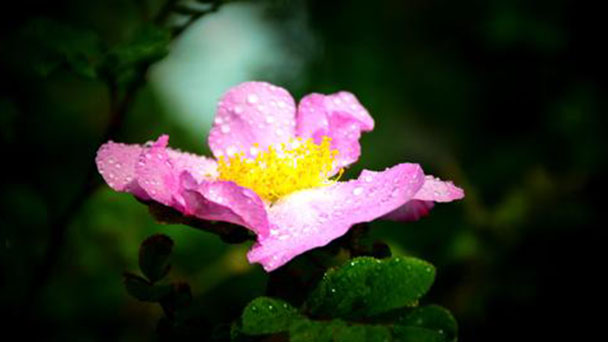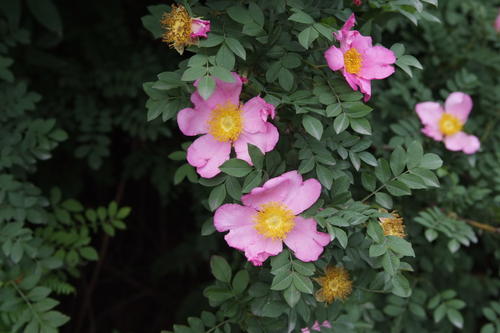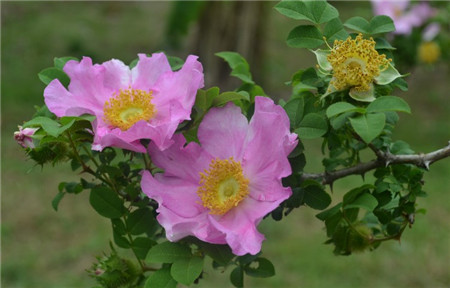Chestnut rose profile
Written by Maggie
Oct 15 2021

Chestnut Rose is distributed in China's Shaanxi, Gansu, Jiangxi, Anhui, Zhejiang, Fujian, Hunan, Hubei, Sichuan, Yunnan, Guizhou, Xizang and other provinces, all over the wild or cultivated. Chestnut Rose is also found in Japan. This flower is cultivated and has high horticultural value.
Chestnut rose flowering period is from May to July, fruiting from August to October.
Chestnut Rose picture

Chestnut Rose major producing area
In China, chestnut rose is mainly distributed in Yunnan, Sichuan, Guangxi, Guizhou, Xizang, Hunan, Hubei, Fujian, Gansu, Shaanxi, Jiangxi, Zhejiang, Anhui and other regions.
Morphological characteristics of Chestnut rose
Chestnut Rose is a shrub. Branchlets are slightly oblate at base and paired prickles. Chestnut Rose has 9-15 leaflets, including petioles 5-11 cm long, leaflets elliptic or oblong, sparse obovate, 1-2 cm long, finely serrate, glabrous on both sides, reticulate veins visible below; Axis and petiole have scattered small prickles, stipules mostly stick to the petiole, free part of subulate, glandular hair on the edge. Flowers are solitary or 2-3 at the apex of short branches. Flowers are 5-6 cm in diameter; The pedicel is short; Chestnut Rose has 2-3 bracteoles, ovate, margin glandular hairy; Sepals are broadly ovate, with pinnate lobes, inwardly densely tomentose, outwardly densely punctured; Petals are double to semi double, reddish or pink, slightly fragrant, obovate, outer larger, inner smaller; Inflorescences are free, hairy, not extruding, shorter than stamens. Flowering period is from May to July, fruiting period from August to October. Rosa oblate is 3-4 cm in diameter, greenish red when ripe, with densely prickled outside; The calyx is erect. Chestnut Rose is wild or cultivated in Anhui, Zhejiang, Fujian, Jiangxi, Hubei, Hunan, Guangxi, Guizhou, Yunnan, E Xizang, Sichuan, S Shaanxi and S Gansu. The fruit is sweet and sour, rich in vitamins, for food and medicine, but also for boiling sugar brewing raw materials; Boil root water for dysentery. The flowers are beautiful to admire. The thorny branches serve as hedges.

The growth habit of Chestnut rose
Chestnut Rose likes to grow in a warm, wet environment and requires plenty of light. Chestnut Rose adaptability is strong, can be cold, slightly shade tolerant, and the soil requirements are not strict, but with fertile sandy loam as well.
Chestnut rose growing methods
Chestnut Rose is suitable for growing between 15 and 25 degrees Celsius, so pay attention to cold prevention and temperature control in winter.
Chestnut Rose loved the light and was exposed to the sun every day.
3. Soil: Choose fertile soil with good drainage and air permeability.
4. Water: The principle of watering is to meet the soil moist state.
Chestnut Rose flower language
Chestnut Rose is a symbol of good, good things and feelings, meaning good luck.
Latest Updated
- Benefits of Bugleweed - 7 Science-backed Health Benefits
- Bugleweed Dangers & Side Effects - Is It Poisonous?
- How to Plant Evergreen Trees - What You Should Know
- When to Plant Evergreens - Grow Guide for Evergreen Trees
- 12 Wonderful Evergreen Shrubs for Your Garden
- 12 Popular Evergreen Plants with Pictures for Beginners
- When And How To Prune A Lilac Bush Like a Pro
- How to Grow & Care for Lilac Vine (Hardenbergia Violacea)
- Japanese Lilac Tree (Syringa Reticulata) Care & Propagation Guide
- Shumard Oak Pros and Cons - What to Know
Popular Articles
- Winter maintenance of Antirrhinum Majus
- How to Grow Terminalia Mantaly Tree
- How to Grow and Care for Crossostephium Chinense
- How to grow Antirrhinum Majus in spring
- Peristeria Elata (Dove Orchid) Profile: Info & Care Guide
- Underwatered Snake Plant (Sansevieria Trifasciata) - Signs And How To Fix
- How to Care for Brazilian Jasmine Plant (Mandevilla Sanderi)
- How to Grow & Care for Graptopetalum Purple Delight in Summer
- Rosa Chinensis (China Rose): Plant Growing & Care Tips
- How to Care for Baby Sun Rose (Aptenia Cordifolia)